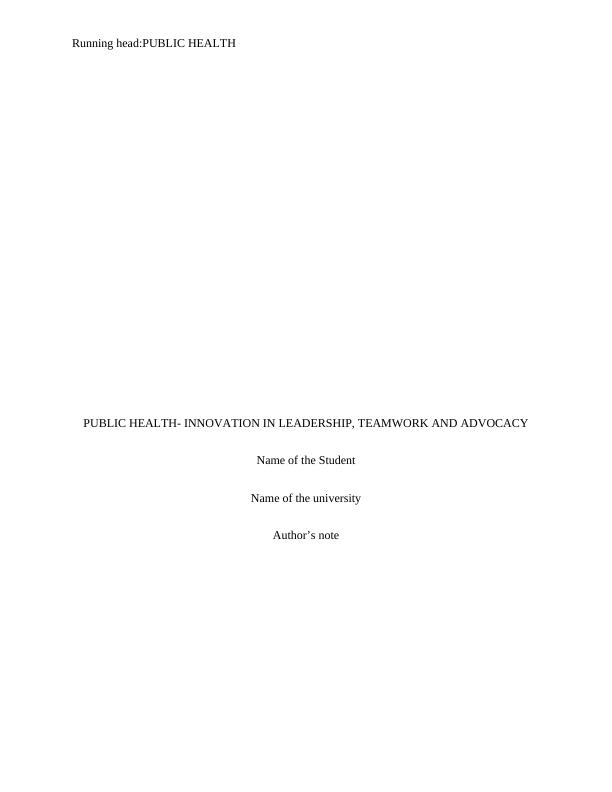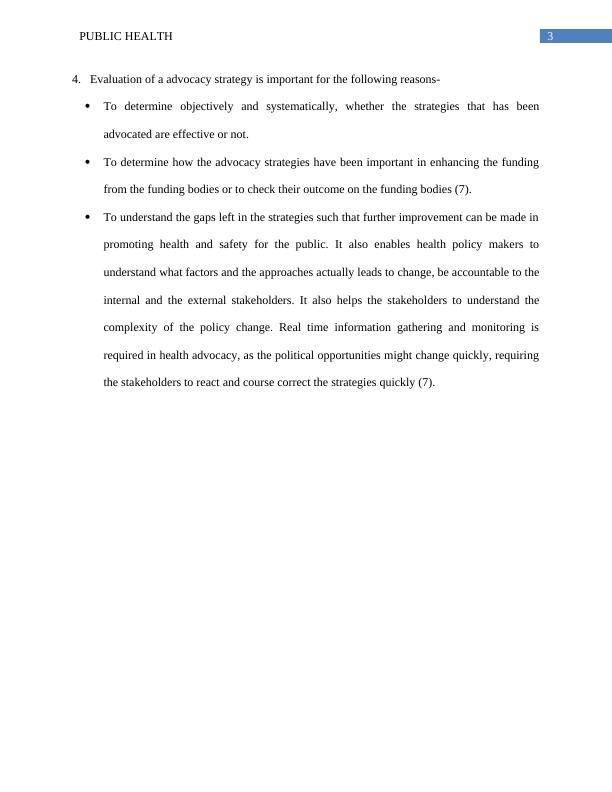Public Health: Innovation in Leadership, Teamwork and Advocacy
Added on 2023-06-10
12 Pages3276 Words84 Views
Running head:PUBLIC HEALTH
PUBLIC HEALTH- INNOVATION IN LEADERSHIP, TEAMWORK AND ADVOCACY
Name of the Student
Name of the university
Author’s note
PUBLIC HEALTH- INNOVATION IN LEADERSHIP, TEAMWORK AND ADVOCACY
Name of the Student
Name of the university
Author’s note

1PUBLIC HEALTH
Part A
1. Difference between Leadership and management
Leadership can be defined as the quality of an individual that influences people such that
objectives are attained enthusiastically and willingly. Leadership can be termed as one of the
element of the management. It is not a lesson that has to be taught but are generally possessed by
individuals. It requires as good vision and directing the people to that shared vision (1). While
management is the discipline of the managing things in the best possible way or it can be defined
as the art of getting things done with the help of the others. Management is not confined to
individuals only but a combination of the 5M- Men, material, money, machine and methods (2).
Leadership normally demands the foresightedness of a leader but the management has
normally a short range of vision. In leadership, the guidelines and the principles are generally
established but in case of management, the procedure and the policies are implemented.
Management is reactive in nature and thrive to bring changes whereas the management is
proactive and works to bring stability in an organization (3).
2. Explain why public health advocacy is important
Public health advocacy can be defined as the activities or the initiatives that attempts to
contribute to the systemic changes in promoting health by influencing the policy processes.
All the definitions of the public health advocacy involves some of the common elements like
an emphasis on collective initiatives to bring about a desired systemic change (4). It also
focuses on changing the factors like the policies, regulations, standard of care and any
institutional practices.
Part A
1. Difference between Leadership and management
Leadership can be defined as the quality of an individual that influences people such that
objectives are attained enthusiastically and willingly. Leadership can be termed as one of the
element of the management. It is not a lesson that has to be taught but are generally possessed by
individuals. It requires as good vision and directing the people to that shared vision (1). While
management is the discipline of the managing things in the best possible way or it can be defined
as the art of getting things done with the help of the others. Management is not confined to
individuals only but a combination of the 5M- Men, material, money, machine and methods (2).
Leadership normally demands the foresightedness of a leader but the management has
normally a short range of vision. In leadership, the guidelines and the principles are generally
established but in case of management, the procedure and the policies are implemented.
Management is reactive in nature and thrive to bring changes whereas the management is
proactive and works to bring stability in an organization (3).
2. Explain why public health advocacy is important
Public health advocacy can be defined as the activities or the initiatives that attempts to
contribute to the systemic changes in promoting health by influencing the policy processes.
All the definitions of the public health advocacy involves some of the common elements like
an emphasis on collective initiatives to bring about a desired systemic change (4). It also
focuses on changing the factors like the policies, regulations, standard of care and any
institutional practices.

2PUBLIC HEALTH
The main aim of health advocacy is to promote wellbeing and resilience in the community.
The importance of the health advocacy is that it helps it helps in promoting good health to the
community, to overcome the barriers that that limits health equality, to promote effective
funding against any public health issue. It is the public health advocacy that helps to protect
the health rights of the people and ensure a safe, healthy and a sustainable community, to
empower the marginalized group who are susceptible to health risks due to family,
environment and socio economic factors (4). It help to challenge stigmatization and
stereotyping against physically challenged or the mentally challenged people, to sustain
financial as well as political commitment. Moreover, the health advocacy helps to bring
positive changes in policies, organization, legislation, health service delivery, attitudes and
the community behavior. Public health advocacy also empowers the health care professionals
to actively take part in the health promotion strategies and the policies. There are many
examples of the public health advocacy in several health care areas such as smoking control,
controlling of the substance abuse, diabetes advocacy program, injury prevention and the
several more (5).
3. Lobbying involves activities that are direct in support or against a particular legislation and
only makes up a small part of the advocacy efforts. Moreover it is an attempt to convince or
influence a public professional or a politician on a particular issue and can be broken down in
to direct lobbying, grassroots lobbying. Whereas advocacy is arguing about a particular cause
or concept, i.e., environmental protection, health issues, minority rights and other issues that
impacts on people every day. Lobbying attempts to influence a special legislation at a local,
state and federal level, while advocacy mainly focuses about education about a particular
issue (6).
The main aim of health advocacy is to promote wellbeing and resilience in the community.
The importance of the health advocacy is that it helps it helps in promoting good health to the
community, to overcome the barriers that that limits health equality, to promote effective
funding against any public health issue. It is the public health advocacy that helps to protect
the health rights of the people and ensure a safe, healthy and a sustainable community, to
empower the marginalized group who are susceptible to health risks due to family,
environment and socio economic factors (4). It help to challenge stigmatization and
stereotyping against physically challenged or the mentally challenged people, to sustain
financial as well as political commitment. Moreover, the health advocacy helps to bring
positive changes in policies, organization, legislation, health service delivery, attitudes and
the community behavior. Public health advocacy also empowers the health care professionals
to actively take part in the health promotion strategies and the policies. There are many
examples of the public health advocacy in several health care areas such as smoking control,
controlling of the substance abuse, diabetes advocacy program, injury prevention and the
several more (5).
3. Lobbying involves activities that are direct in support or against a particular legislation and
only makes up a small part of the advocacy efforts. Moreover it is an attempt to convince or
influence a public professional or a politician on a particular issue and can be broken down in
to direct lobbying, grassroots lobbying. Whereas advocacy is arguing about a particular cause
or concept, i.e., environmental protection, health issues, minority rights and other issues that
impacts on people every day. Lobbying attempts to influence a special legislation at a local,
state and federal level, while advocacy mainly focuses about education about a particular
issue (6).

3PUBLIC HEALTH
4. Evaluation of a advocacy strategy is important for the following reasons-
To determine objectively and systematically, whether the strategies that has been
advocated are effective or not.
To determine how the advocacy strategies have been important in enhancing the funding
from the funding bodies or to check their outcome on the funding bodies (7).
To understand the gaps left in the strategies such that further improvement can be made in
promoting health and safety for the public. It also enables health policy makers to
understand what factors and the approaches actually leads to change, be accountable to the
internal and the external stakeholders. It also helps the stakeholders to understand the
complexity of the policy change. Real time information gathering and monitoring is
required in health advocacy, as the political opportunities might change quickly, requiring
the stakeholders to react and course correct the strategies quickly (7).
4. Evaluation of a advocacy strategy is important for the following reasons-
To determine objectively and systematically, whether the strategies that has been
advocated are effective or not.
To determine how the advocacy strategies have been important in enhancing the funding
from the funding bodies or to check their outcome on the funding bodies (7).
To understand the gaps left in the strategies such that further improvement can be made in
promoting health and safety for the public. It also enables health policy makers to
understand what factors and the approaches actually leads to change, be accountable to the
internal and the external stakeholders. It also helps the stakeholders to understand the
complexity of the policy change. Real time information gathering and monitoring is
required in health advocacy, as the political opportunities might change quickly, requiring
the stakeholders to react and course correct the strategies quickly (7).

End of preview
Want to access all the pages? Upload your documents or become a member.
Related Documents
Public Health: Leadership and Management, Advocacy, Lobbying, and Evaluation Strategieslg...
|16
|4314
|59
Answers to Questions About ADVOCACY ADVOCACY Name of the University Authorlg...
|14
|3352
|110
Health Promotion and Nursing roles on management of Diabetes Mellituslg...
|7
|2230
|136
Leadership in Public Healthlg...
|8
|2186
|24
Nursing as Advocacylg...
|6
|1132
|424
Public Health Administration and Leadershiplg...
|5
|1028
|44
